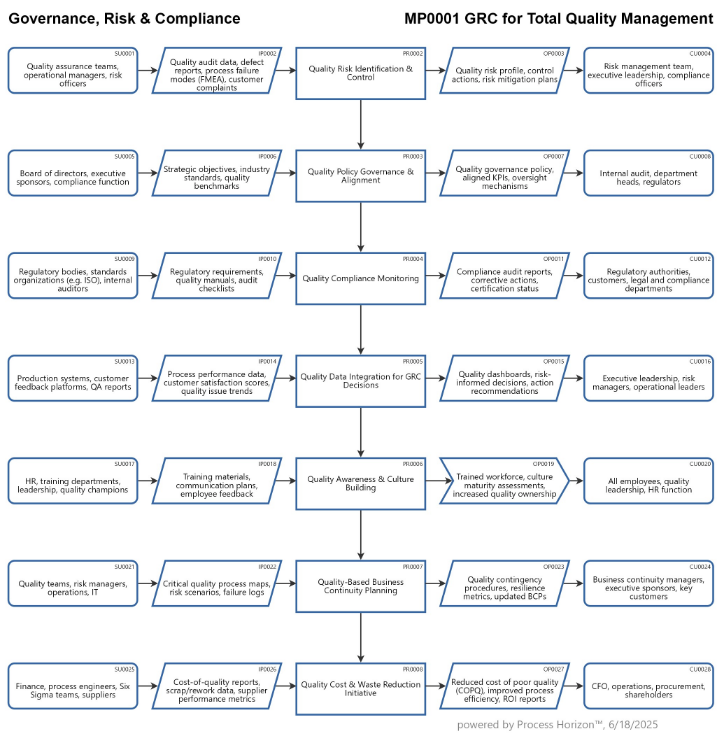Governance, Risk & Compliance for sustainable TQM

Managing Total Quality Management (TQM) as part of Governance, Risk, and Compliance (GRC) brings alignment, efficiency and resilience to an organization.
1. Holistic Risk Management
- TQM identifies quality risks (e.g. defects, process inefficiencies, customer dissatisfaction) that can jeopardize compliance, reputation and financial performance.
- When part of GRC, quality risks are managed systematically alongside financial, operational and strategic risks, avoiding siloed responses.
2. Strengthened Governance
- TQM emphasizes leadership commitment, accountability and continuous improvement which are core elements of good governance.
- Integrating TQM into governance ensures quality objectives align with strategic goals, and executive oversight includes quality metrics.
3. Regulatory Compliance
- Many industries (e.g. pharma, automotive, aerospace) require adherence to quality standards (like ISO 9001, IATF 16949).
- Embedding TQM within GRC ensures consistent compliance with external regulations and internal standards, minimizing legal and reputational risks.
4. Improved Decision-Making
- TQM generates data on process performance, customer satisfaction, and nonconformities.
- In a GRC framework, this quality data is used to inform enterprise-wide decisions, including risk mitigation strategies and control improvements.
5. Cultural Alignment
- TQM and GRC both promote a culture of accountability, transparency, and continuous improvement.
- Managing TQM within GRC reinforces these values across the organization, reducing silos and improving collaboration.
6. Operational Resilience
- TQM contributes to process robustness & reliability, which are essential for business continuity.
- GRC frameworks benefit from integrating TQM to enhance resilience against disruptions, whether from supply chain issues or quality failures.
7. Cost Efficiency and Value Creation
- Quality failures often result in rework, recalls, penalties and loss of customer trust.
- When TQM is embedded in GRC, early detection & prevention mechanisms reduce costs and drive long-term value.
Plan & Build
Quality by Design (Planning and Materials):
Quality in house construction begins with a well-thought-out design (QbD) and the selection of appropriate materials, as these define the structural integrity, functionality and long-term durability of the building.
Quality by Execution (Construction Process):
Even the best plans and materials can fall short without skilled execution; construction quality is ultimately realized through precise workmanship, adherence to standards and attention to detail during every phase of the build.
Using the following link you can access this sandbox SIPOC model in the ProcessHorizon web app and adapt it to your needs (easy customizing) and export or print the automagically created visual AllinOne SIPOC map as a PDF document or share it with your peers: https://app.processhorizon.com/enterprises/EKUMEedjaQVDk1amWhRzXZJD/frontend

